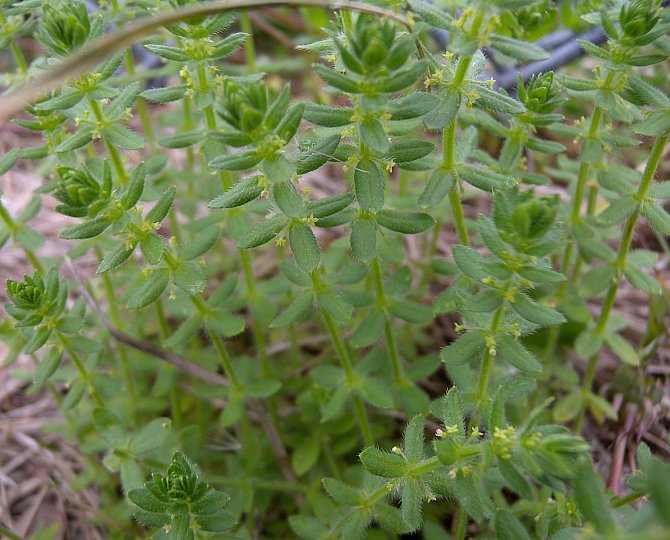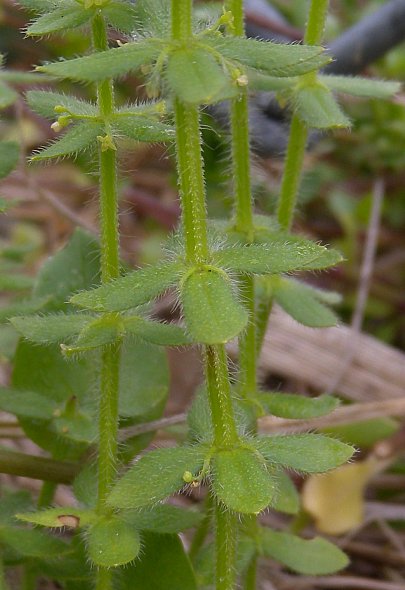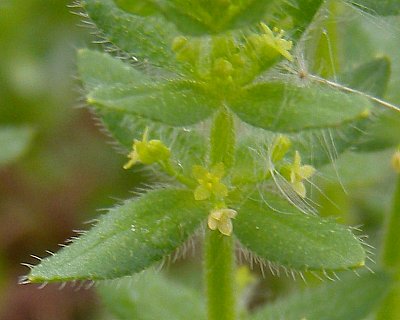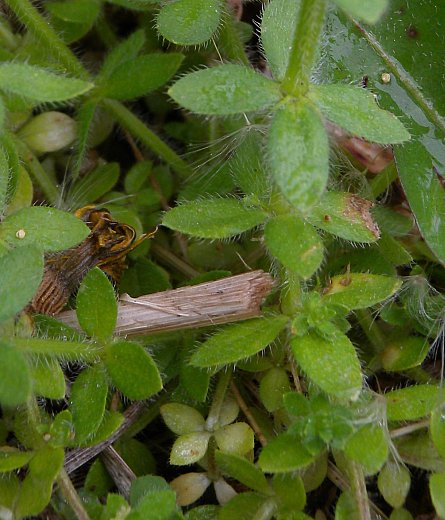
Either solitary or small cymes of 2-4 flowers develop from the axils of the lower-middle to upper leaves. Each perfect flower is about 1.5 mm. (1/16") across, consisting of a pale yellow 4-lobed corolla, a short inconspicuous calyx, 4 short stamens with yellow anthers, and a green pistil. The lobes of the corolla are oblong-ovate in shape and widely spreading. Some flowers may be imperfect, lacking either male or female reproductive organs. The peduncles of the cymes are 2-4 mm. long and hairy. The pedicels of the flowers are about 1 mm. long. While they are still in bloom, the flowers are usually held above the whorled leaves. Shortly after they bloom, the peduncles droop and the developing fruits of the flowers are usually held below the whorled leaves. The blooming period occurs from late spring to mid-summer, lasting 1-2 months, if not longer. The fruits are bilobed-globoid in shape and smooth (lacking prickles), spanning about 1.5 mm. across at maturity. Each fruit has 2 seeds. The root system consists of a slender taproot. This plant spreads by reseeding itself.

Cultivation: The preference is full or partial sun and mesic to dry conditions. Various soil types are tolerated, including those that contain clay-loam and sandy loam. Most growth and develop occurs during the spring and early summer. This weedy plant dies down by autumn.
Range & Habitat: The non-native Foothill Bedstraw (Galium pedemontanum) is apparently rare in Illinois; there are records of it occurring in three counties (Champaign, Lawrence, and Mason counties); see the Distribution Map (ILPIN; Marcum et al., 2013; Phillipe et al., 1996). However, this plant is undoubtedly more common than these records indicate, and it is probably still spreading. Foothill Bedstraw is native to southern Europe, Asia Minor, and adjacent areas of Asia. It was first detected in the United States near Lexington, Kentucky, in 1933 (Wikipedia). Since then, it has spread to many states in the eastern and south-central United States.

Disturbed habitats include edges of yards, grassy fields, roadsides, areas along railroads, fence rows, areas along the base of buildings, areas at the base of rock-masonry walls, and waste ground. Natural habitats include thickets, sandy savannas, woodland borders, and upland prairies. However, Foothill Bedstraw is found primarily in disturbed habitats that are not subject to regular mowing in the United States.
Faunal Associations: The tiny flowers probably attract small bees and flower flies. Both pollen and small amounts of nectar are available as floral rewards to such visitors. Insects that feed destructively on bedstraw species (Galium spp.) include various species of aphids and moth larvae.

Photographic Location: Along a metal fence near a sidewalk in Urbana, Illinois.
Comments: In Illinois, this non-native bedstraw (Galium) can be recognized by its tiny yellow flowers (about 1.5 mm. across) on short cymes, whorls of 4 leaves, smooth fruits on peduncles that droop below the leaves, and hairy foliage. Another non-native species that uncommonly occurs in Illinois, Galium verum (Yellow Bedstraw), also has yellow flowers, but they are produced in larger inflorescences and they are more showy. Native species of bedstraw within the state have white, greenish white, or purplish red flowers. Because Foothill Bedstraw, also referred to as Piedmont Bedstraw, is rather small in size and its flowers are inconspicuous, it is easy to overlook. In Europe, this plant is usually referred to by another scientific name, Cruciata pedemontana.